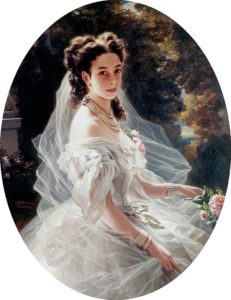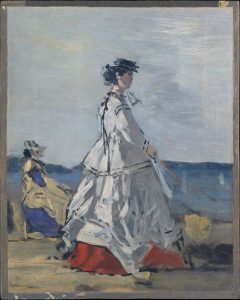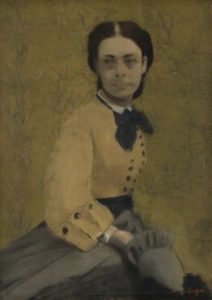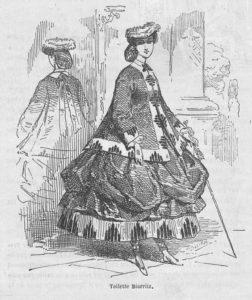 by Kasia Stempniak, Guest Contributor
by Kasia Stempniak, Guest Contributor
In August of 1892, several French and British newspapers reported a curious incident that had purportedly taken place that summer:
Princess Pauline de Metternich and the Countess Kielmansegg, two members of the Committee for the Vienna Exhibition of 1892, settled a dispute by fighting each other in a duel with rapiers that lasted three rounds. No men were present and the women suffered minor injuries.
The news report reads like a fait divers, a type of sensational story often published in newspapers in the nineteenth-century. Apocryphal or not (Pauline de Metternich would have been 56 years old at the time), the story is just one of the many spurious anecdotes surrounding the princess. Born in Austria on February 26, 1836, to a Hungarian count and an Austrian princess, Pauline Clémentine von Metternich-Winneburg zu Beilstein became a veritable celebrity in mid nineteenth-century Paris where she had a significant influence on the cultural and social scene.
“La fête impériale”
In a century full of conflict and revolutions, the Second Empire stands out as a period synonymous with spectacle, ostentation, and lavish spending. At the center of this culture of the “imperial feast” or “fête impériale” one could easily find Pauline de Metternich. When her husband Prince de Metternich (who happened to be her uncle as well) was appointed Austrian Ambassador to Napoléon III’s court in 1859, the twenty-three year-old moved to France, where she quickly adopted the Parisian lifestyle. A fashion aficionado and socialite, Pauline was considered by some to be “more Parisian than the rue de la Richelieu,” despite being a foreigner. She was famous in her time for her sharp wit and love of cigars — a habit that was ordinarily unheard of for a woman of her position. While her unconventional qualities charmed many of her contemporaries, including Napoléon III’s wife, the Empress Eugénie, with whom she became close friends, others were less taken. Some, like the Count Horace de Viel Castel, disapproved of the way the diplomat’s wife “drinks, smokes, swears, [and] is scarily ugly”— not to mention “the stories she tells!”[1]
The Metternichs were frequent guests of Napoléon and Eugénie at their chateau retreats in Compiègne and Fontainebleu, where they took part in balls, elaborate dinners, hunting escapades, tableaux vivants, and even plays.

Winterhalter, 1860
By the mid-1860’s, the Metternichs were well-known for their salon gatherings and for hosting elaborate balls themselves. “She had the rare gift,” wrote one contemporary observer, “of bringing animation and life to wherever she appeared.” [2] During the 1867 Paris World Exhibition, Pauline secured funding from her home country for the construction of the Austria-Hungary Pavilion as well as for hosting a prestigious ball for the Exhibition, in which Johann Strauss debuted his “Blue Danube Waltz.” She cultivated relationships with prominent musicians and writers of the time including Alexandre Dumas, Franz Liszt, and the composers Richard Wagner and Charles Gounod. In fact, it was thanks to Pauline that Wagner performed for the first time in Paris in 1861 with his production of Tannhauser. The premiere was a failure, however, and sparked the (false) story that Pauline had been so angry at the crowd who had booed the performance that she broke her fan. [3]

Boudin, Princess Pauline Metternich on the Beach ca. 1865-67 (Courtesy of the Met)
While the press often mocked her looks, Pauline embraced this aspect of her appearance by self-deprecatingly referring to herself as a“fashionable monkey” (un singe à la mode) and even exclaiming sometimes, “Wherever I go, people follow me, but when I turn around, they flee!” Despite any misgivings she and others may have had regarding her appearance, she was the subject of several notable artistic and photographic works. In addition to Winterhalter, Pauline was painted by Impressionist Eugène Boudin as well as Edgar Degas.
A photograph of Pauline by André Adolphe Eugène Disdéri from 1861 inspired Degas to produce a striking portrait of Pauline. Her blurred facial features and canary yellow corsage take center stage in what is considered to be one of the earliest examples of art inspired by photography.

Degas, “Princess Pauline de Metternich,” ca. 1865
Each of these paintings and photographs managed to capture one of Pauline’s biggest claims to fame– her sartorial ingenuity.
Tastemaker

Metternich in La Vie Parisienne (courtesy of Agorha, INHA)
“Whoever says: “Mme de Metternich” says innovation, whimsy, and the unexpected,” wrote the journal La Vie Parisienne in 1863. Pauline’s penchant for eccentricity and rule-breaking translated into her wardrobe, which became a regular talking point in the fashion and society columns. The same report in La Vie Parisienne describes an outfit Pauline wore in the resort town of Biarritz, one that she had accessorized with a particularly avant-garde hat: “Yes, a cap, mischievous, roguish, provocative that no woman would have dared be the first to wear, but that all will adopt today.”
Like her cap, Pauline was unafraid to push the boundaries with fashion, having complete confidence in her dressmaker, the Englishman Charles Frederick Worth. Considered today to be the “father of haute couture,” Worth set up his shop at 7 rue de la Paix in 1858. But it was not until he cultivated a relationship with Pauline that he was catapulted into the annals of fashion history. In her memoirs, she recalls the day Worth’s wife approached her with drawings he had sketched for her. Pauline initially refused to look at them, shocked that he was male and English. But after noting the originality of his drawings, she decided to test him with an order of two dresses, each one for the low price of 300 francs. She wore one of the dresses, a white tulle gown “trimmed with crimson-hearted daisies,” to the ball at the Tuileries. Legend has it that the Empress Eugénie was so taken with the dress that she requested a meeting with Worth the next morning. Pauline jokingly laments that at that moment, “Worth was launched and I was done for; no dress costing three hundred francs ever again saw the light of day.” [4]
“Lorette” or Grande dame?
Pauline de Metternich regularly attended what were considered low-brow entertainments like café-concerts and operettas. Her theater preferences, coupled with her reputation as a socialite and fashion icon, provided fodder for the press, who turned her into a nineteenth-century celebrity. Prosper Merimée, the famous author of Carmen, described Pauline as “a genre of originality composed of two parts lorette and one part grande dame.” [5] “Lorette” was a nineteenth-century ‘type’ that referred to usually lower-class, fashion-conscious kept women. Merimée’s observation, along with those of other (males) of the period, shows an unease with the way in which Pauline, a wife of a diplomat, took advantage of the wide variety of entertainment Paris offered. For some, Pauline embodied what they saw as the dangerous mixing of the aristocratic world and the demi-monde.
End of an Era
Although Austria and France had been enemies in battle in 1849 and as recently as 1859, the Metternichs and Napoléon III enjoyed a close relationship up until the events of 1870. That year, the splendor and festivities of the Second Empire came to a screeching halt with the Franco-Prussian War, a conflict that saw Napoléon III ousted from power. Pauline, along with most of Napoléon’s court, fled from France, an event she recounts in detail in her memoirs.
After 1871, Pauline stayed out of the limelight until her death in 1921. Her name, however, consistently appears in society columns well into the 20th century, with some rehashing apocryphal anecdotes (like the report of her duel) that Pauline would later refute in her memoirs. Indeed, her decision to dedicate her last years to writing suggests a desire to have the final word in crafting the narrative of her life. A non-conventional woman who challenged the norms of the time with her eccentricity and outsize personality, Pauline de Metternich remains a fascinating figure in nineteenth-century history.
Kasia Stempniak is a PhD student in Romance Studies at Duke University. Her research examines the relationship between fashion, urban space, and the body in nineteenth-century French literature and culture.
Further reading:
[1] Viel Castel, Horace de. Mémoires du comte Horace de Viel Castel sur le règne de Napoléon III. Vol. VI. Paris, 1884.
[2] Mme Carette, Souvenirs intimes de la Cour des Tuileries, Ed. Paul Ollendorff, Paris, 1889.
[3] See Emmanuel Haymann’s biography Pauline Metternich, la jolie laide du Second Empire. Paris: Perrin 1991 and Philippe Luez’s biography Pauline de Metternich, l’éventail brisé, Payot, 2004.
[4] For more, see Metternich’s memoir, My Years in Paris (1922).
[5] Mérimée, Prosper. Lettres à une inconnue, ed. Michel Lévy, 1874, 2 vol.
